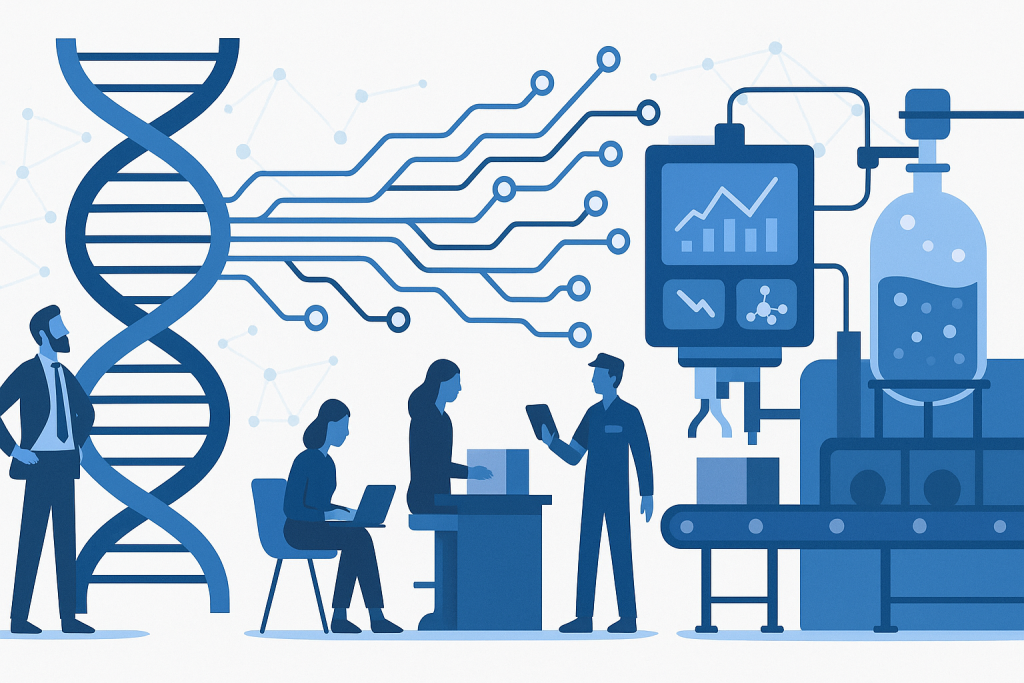The next industrial revolution won’t be powered by metal or oil—it will be written in code and DNA.
The Evolution of the Factory
Factories used to shape materials. Now they shape information and life.
For over two centuries, “factory work” meant physical production—assembling goods through machinery, labor, and energy. The modern factory, however, is undergoing a transformation as profound as the industrial revolution itself.
Today, automation and synthetic biology are converging to create bio-intelligent factories—systems that use living cells, data, and algorithms to produce materials, food, medicine, and energy.
The result is a new kind of production floor: one where robots, microbes, and human designers collaborate to manufacture life-based solutions.
DNA as the New Machine Code
Biology has become programmable.
Synthetic biology treats DNA the way computing treats code: as a programmable system. By editing genes and controlling metabolic pathways, scientists can instruct cells to produce specific molecules—plastic alternatives, proteins, fuels, or pharmaceuticals.
Instead of building physical machines to perform tasks, we now engineer organisms to perform functions.
In the future factory:
- DNA replaces blueprints.
- Cells replace assembly lines.
- Algorithms replace supervisors.
And just as early computing transformed office work, this biological programming will redefine industrial work itself.
The Rise of Bio-Automation
Automation is moving from hardware to wetware.
AI-driven tools now design biological systems faster than humans can. Machine learning algorithms predict how DNA sequences will behave, optimize microbial production, and monitor fermentation systems in real time.
On the new factory floor, robotic systems handle physical processes—feeding cultures, maintaining temperature, harvesting output—while algorithms handle decision-making.
This integration creates self-correcting production ecosystems, where biology and automation continuously learn from each other.
The line between factory and organism is starting to blur.
Human Work in a Biological Economy
As factories become smarter, human work becomes more conceptual.
The future of bio-based manufacturing doesn’t eliminate human workers—it transforms their role. Instead of repetitive tasks, workers will focus on designing, managing, and interpreting biological systems.
Key new roles include:
- Bio-designers who program living systems for specific outcomes.
- Systems engineers who maintain the interface between machines and microbes.
- Ethics and compliance specialists ensuring safe, responsible biological deployment.
- Data analysts who translate biological behavior into actionable metrics.
In short, humans move from operators to orchestrators—shaping how technology and biology work together.
Education for the Living Factory
Tomorrow’s workforce needs literacy in both data and DNA.
Preparing students for this future means teaching them to think across disciplines. Biology will no longer be a standalone science—it will sit alongside computer programming, robotics, and environmental systems as a foundation for problem-solving.
For parents and educators, the key is to emphasize bio-literacy and digital literacy together. Students must learn not only how biological systems work, but how to design, simulate, and control them ethically.
Schools can begin this shift through hands-on labs, interdisciplinary projects, and curricula that blend coding, design, and sustainability.
The next “shop class” might involve genetic simulation software and AI modeling rather than wrenches or circuits.
Economic Implications: Work That Regenerates
Automation once replaced labor. Now it can restore ecosystems.
Bio-based factories have the potential to produce not just more efficiently, but more responsibly.
Microbial production can run on renewable feedstocks, operate at ambient temperatures, and generate minimal waste. This means the new factory floor can also be a site of environmental regeneration—turning emissions into resources or waste into raw materials.
The workforce of the future will measure success not by how much is produced, but by how sustainably it’s done.
That shift redefines economic value itself: growth measured in resilience, not just revenue.
Ethics and Oversight in Living Systems
Power over life must come with accountability.
As humans gain the ability to design and deploy living systems, questions of control and consequence become critical.
Who owns a bioengineered organism once it’s released? How do we regulate AI systems that evolve living matter?
Governments, industries, and educators will need to collaborate on frameworks that emphasize transparency, traceability, and responsibility. Ethical literacy will become as important to the bioeconomy as coding skills are today.
The challenge isn’t just building the new factory—it’s governing it.
Conclusion: The Living Future of Work
The factory floor is no longer made of concrete. It’s a hybrid ecosystem—where automation, AI, and biology combine to create a regenerative form of industry.
The future of work will require humans who understand both the mechanics of machines and the logic of life.
This isn’t the end of labor. It’s the beginning of living work—where creation and care coexist, and where making something new also means helping the planet heal.
The next revolution won’t be built.
It will be grown.


